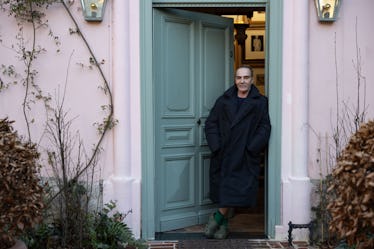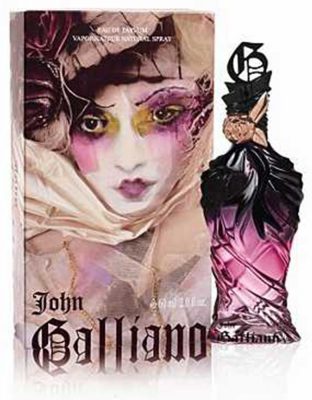
In High & Low: John Galliano director Kevin Macdonald confronts the designer’s fall from grace and whether or not art should be separated from the artist.
…
W CULTURE: Even if you’ve never set foot in a cinema, you’ve likely seen the beginning of the new John Galliano documentary, High & Low, which premieres today on Mubi. The film opens with the designer’s most vile and viral moment, a bilious 2011 rant at a Paris cafe, where the fashion designer praises Hitler and condemns Jews and Asians. “The incident,” as Galliano refers to it, was captured on a smartphone, shared globally, et voila. Galliano was fired from his job as Dior’s much-lauded creative director, condemned by online fans, and skewered by Taran Killam on Saturday Night Live. “I am winning at life; I look like a pirate on meth!” he proclaimed, as Miley Cyrus giggled beside him.
It was a dark time for the fashion community and an especially painful one for its Jewish and Asian members, many of whom grew up admiring Galliano’s creative genius. (Real talk: as one of those members, I was so gutted when looking at my one Galliano piece—a pink princess dress embroidered to perfection with tiny gold flowers—that I ended up selling it on eBay. It was one of the most beautiful things I’ve ever owned. I still don’t regret giving it up.)
“I decided early on I had to open with his rant,” says High & Low director Kevin Macdonald, the Academy Award-winning Scottish filmmaker who the past few years completing the movie. “If I didn’t, everyone would say, ‘Oh, they’re just showing all the beautiful stuff. They want us to think he’s a genius, and then we’re gonna get to the elephant in the room.’ But no. You can’t make a film about John Galliano that starts with beauty.”
Instead, Macdonald approached Galliano’s very real cycle of rise-fall-repeat the way he approached his previous fictional thrillers—like The Last King of Scotland and State of Play: like a psychological detective. “[Galliano] is an enigmatic, mysterious character. You ask, ‘Why did he do that?’ What’s extraordinary, to me, is that he doesn’t understand why he did what he did! It was my job to figure out what happened.”
Macdonald begins at the beginning, with Galliano’s abusive childhood in Gibraltar, Spain. Astonishingly, he grew up on a street called Serfaty’s Passage in honor of the country’s Jewish residents, most of whom were stoned, drowned, or burned at the stake during the Inquisition. Many who escaped, including my ancestors, fled to Africa. “Oh, I know!” Macdonald said when I mentioned the irony. It turns out he, too, is a child of the Jewish diaspora and a descendent of Holocaust survivors, albeit one with a rad Scottish accent.
But Macdonald’s heritage wasn’t the only driving force behind his curiosity. Instead, he admits a deep fascination with the kind of artistic drive that can lead to absolute ruin—a consequence, in part, of his childhood: his grandfather was the director of the classic 1948 ballet drama The Red Shoes. Macdonald was also searching for a vehicle to explore cancel culture, and the question of who “deserves” forgiveness when our sins are captured live and online. “I had the idea during lockdown,” he says. “So many people were getting ‘canceled’ but you never heard what happened after that. Did they grow? Did they change? Did they just vanish forever? A friend said that they knew Galliano, and that I should speak to Anna Wintour, because she’s like his guardian angel.”
…

Galliano and Anna Wintour
Mubi

Mubi
After getting the famed AW OK, Macdonald visited the designer in Paris, and during a face-to-face meeting, they came to a mutual but tepid entente. “I think we were both sizing each other up, to be honest!” Macdonald says laughing. “We both had our agendas. I wanted to make a really interesting, complicated film about all of these issues. He wanted a film that was fair, good, and made with the right person to sympathize with him. I don’t know why he didn’t want a ‘fashion’ person to do it. Maybe you all know too much?!”
Ultimately, Galliano granted Macdonald an all-access pass to his life, including his home, his studio, and his cabal of iconic fashion friends, including Naomi Campbell, Kate Moss, Charlize Theron, Penélope Cruz, and Wintour herself. “Although he might not admit it, he wanted a film to be made. You know, he’s got a big ego and he’s like, ‘Well, Alexander McQueen has a great film [about him.] So there’s a little bit of that! And also, more seriously, there’s a side to him which is like, ‘I know not everyone is going to forgive me, but I want people to understand me. Once they have the information, they can make up their mind.’”
To begin the process of (literally) framing John Galliano, Macdonald attached a mirror to his camera, which let Galliano make eye contact with the director instead of a blank, black lens. He brought it to a village in the south of France where Galliano sleeps in a bohemian villa above the rocky cliffs. “I thought about that famous sequence with Napoleon, where he’s on the rocks surveying the sea. I said to John, ‘Wait, let’s reenact that,’ and he was so charismatic and committed to it. It was really exciting, but not surprising, because he is, after all, a master storyteller.”
But while Napoleon died in exile, Galliano is currently experiencing a second ascent into the fashion stratosphere thanks to his astounding work at Maison Martin Margiela—something Macdonald witnessed firsthand during the filmmaking process. “Before High & Low, I had a pretty dismissive view of fashion,” admits Macdonald. “I felt like it was very superficial. Following him as he worked at Margiela, and then looking at the archives of his work at Dior, I realized that fashion reflects society at any given moment. Even besides the incredible craftsmanship and work and artistry that goes into it, fashion can tell the most incredible stories and build the most vivid characters. I’m surprised John hasn’t done film costumes yet.”

Galliano today
Mubi
…
I ask if Hollywood would allow Galliano back into its orbit, especially as a full-on collaborator. “There were a few celebrities who absolutely did not want to talk about their relationship with Dior or Galliano, and fair enough,” he says. “There were also some people who worked quite closely with him who did not want to see him again. Others agreed to speak with me, but then they said basically nothing. They wanted to appear supportive of him, but they couldn’t give me what I needed, which was to look at the camera and tell the truth.”
I mention that a mentor of mine was one of Galliano’s early collaborators, and is nervous to bring any chaotic energy back into their life. Macdonald nods, his smile wide—he’s been in the eye of that storm for nearly five years, and just emerging from it now.
“His mind is kind of a black box, and I don’t know if he’s ever forgiven himself for what happened,” he says. “I was with him when Kanye had his own [antisemitic] meltdown, and he was shocked by it. Really, really upset. He knows his hateful behavior will be the first line of his obituary. It’s like a tattoo, you know? He carries it around forever. And my sense is that, by talking about it, it’s almost a liberation for him. He wants to get on doing what he’s good at. People can decide for themselves whether to engage in that work.”
I’m curious if Macdonald can move past Galliano’s moments of hate, not just as a Jew but also as an artist whose own storytelling often jams beauty and fear together in the same frame. He is, after all, the man who created How I Live Now, an indie thriller that follows Saoirse Ronan through a nuclear apocalypse and subsequent societal collapse. “It’s funny you ask because, in a way, that movie is so similar to this one!” he exclaims. In both cases, there are ticking bombs that ultimately destroy something beautiful.
“You know, I’m still too close to this whole film to process real emotions about it,” he says judiciously. “But would I let John Galliano dress me? I mean, I don’t want to look like a chimney sweep or anything. But honestly, yes, I would love it. I would be so happy if he ever did a suit that I wore. I would welcome another collaboration.”
High & Low: John Galliano is now in theaters in the US and UK.
…
by Faran Krentcil
_____________________________________________________________________________
SWOW SWAG




